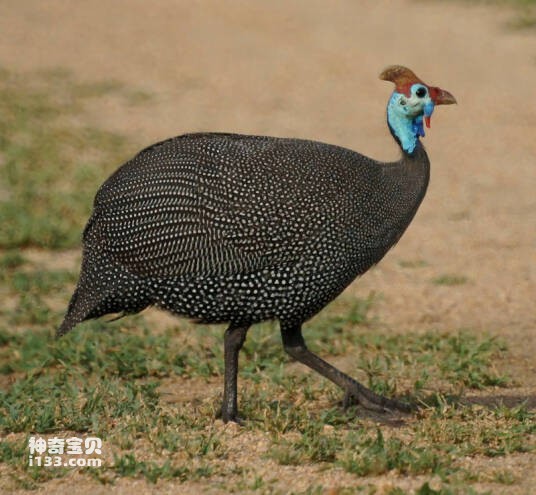Numida meleagris
IUCN
LCBasic Information
Scientific classification
- name:Numida meleagris
- Scientific Name:Numida meleagris,Helmeted Guineafowl
- Outline:Landfowl
- Family:Gallinariformes Gallinariidae Gallinariformis
Vital signs
- length:53-68CM
- Weight:1135-1823g
- lifetime:No textual research information is available
Feature
A horn shaped bony helmet with a horny protruding head
Distribution and Habitat
Place of origin: Angola, Benin, Botswana, Burkina Faso, Burundi, Cameroon, Central African Republic, Chad, Congo, Democratic Republic of the Congo, Cote d 'Ivoire, Equatorial Guinea, Eritrea, Ethiopia, Gabon, Gambia, Ghana, Guinea, Guinea-Bissau, Kenya, Lesotho, Liberia, Malawi, Mali, Mauritania, Morocco, Mozambique, Namibia, Niger, Nigeria, Rwanda, Saudi Arabia, Senegal, Sierra Leone, Somalia, South Africa, South Sudan, Sudan, Eswatini, United Republic of Tanzania, Togo, Uganda, Yemen, Zambia, Zimbabwe.
Introduced to: Antigua and Barbuda, Bahrain, Cape Verde, Comoros, Cuba, Dominican Republic, Madagascar, Mauritius, New Zealand, Portugal, Puerto Rico, Saint Kitts and Nevis, SAO Tome and Principe, Spain, United States, United States Virgin Islands.
Inhabits open savanna or farmland interspersed with shrubs and trees. Prefers to grow in warm, rather dry conditions.
Appearance
It has a body length of 53-68 cm, a wingspan of 95-100 cm and a weight of 1135-1823 g. The main feature is a horn shaped bony helmet with a horny protruding on the top of the head. Bare neck with dark or rough wrinkled skin. It is a black base with white spots, like pearls. The male is black on top and crest. The exposed face is bluish-gray. The body feathers are mainly dark brown with yellow and dark brown red markings on the skin. There are white spots on the wings and tail feathers and eye spots with iridescent gray-green, purple and yellowish skin, lined up on the inner flight feathers, and the outer ring is black and yellowish skin. The female is black on top with brown and yellowish feathering, and the crown feathers are dark gray. The exposed face is bluish-gray. The hind head is chestnut brown. The body feathers have black markings and stripes, as well as brown-like markings of maroon, chestnut, and yellow skin. Iris brown; Mouth light blue or white; Legs, feet near red.
Details
The Helmeted Guineafowl (Numida meleagris) has nine subspecies.

Helmeted beaded chickens are land birds and prefer to live in groups, forming groups of about 25 individuals outside of the breeding season. When you panic, you run around instead of flying away. However, like most short-winged and broad-winged birds, they are very agile and powerful, able to hover and even fly backwards when necessary. Is a very capable runner, can run 10 kilometers or more a day. When disturbed, it will make a loud and violent cry.
The chicken's diet consists of a variety of animal and plant foods, including seeds, fruits, vegetables, snails, spiders, worms, insects, frogs, lizards, small snakes, and small mammals. Like a domestic chicken, its powerful claws can easily dig through the soil to find food. They have a very developed spur length and are used with great effect in fighting.
The breeding period is almost always during or after the rainy season, mainly September-January in southern Africa, February-March in Namibia, and December-April in Malawi. Each clutch can lay a large number of eggs, 20 to 30, in a nest hidden in the grass, the female incubation period is 26 to 28 days. The chicks are colorful and fast growing, and within a week of hatching, they can leap onto low branches on their own with their wings.
Listed on the International Union for Conservation of Nature (IUCN) 2016 Red List of Threatened Species ver 3.1 - Not Threatened (LC).
Protect wild animals and eliminate wild meat.
Maintaining ecological balance is everyone's responsibility!








